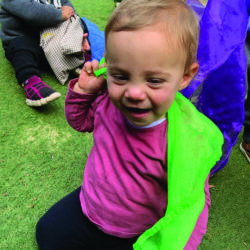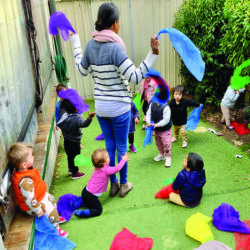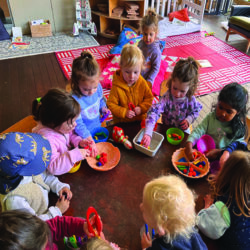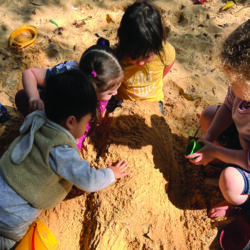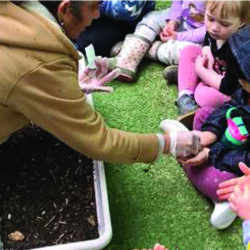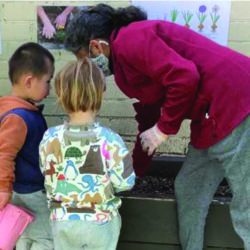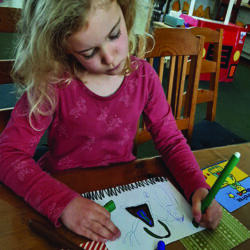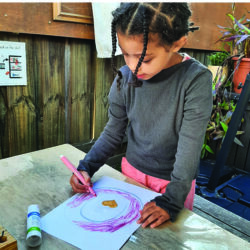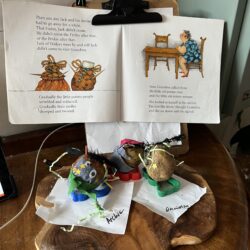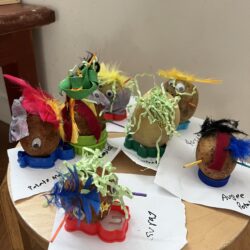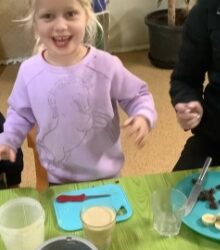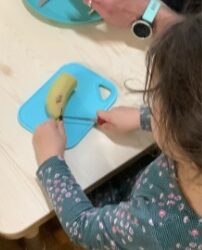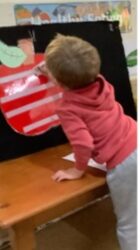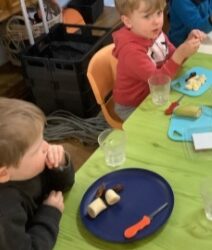Gorton House
Infants
Story by Educator Chamani
In Gorton House infants’ room, the children have started to spend more time outdoors experiencing the beautiful weather. It has been a challenging period recently with so many weather changes, however, this week has been a great week for all of the children as they had the opportunity to use our outdoor space. Mostly we use our outdoor space to participate in singing activities and to spend time in the sand pit.
An ‘action song’ is simply any song or nursery rhyme that encourages a child to move by either following the directions in the song or making certain movements to ‘act out’ the lyrics. For our action song group times this week we used colourful scarves, which the children loved. Two of the main songs that we used for scarf dancing were ‘Jiggle your Scarf’ and the ‘Wibble Wobble’ song. Every time these songs were played, the children got so excited, wagging their scarves up, down and from side to side.
Music and movement are critical for children’s early brain development. Singing, and the rhyming that happens with it, supports children’s social skill and vocabulary development and their ability to regulate emotions. Also, action songs can improve children’s hand-eye coordination as, while they are learning the song, they are also acting it out. This is a great way to improve children’s physical movement skills and muscle coordination. Other benefits of action songs include:
- Developing listening skills and the ability to follow directions.
- Enhancing reading readiness.
- Promoting creativity.
- Fostering self-confidence.
Experiences such this as are very important to every child’s development.
Toddlers
Story by Educator Afroza
Our Gorton House toddler children are very confident and independent. Recently some of the children asked to pick up their favourite fruits from a tray, and they were keen to pick the fruit up by themselves. Today I gave them some child-friendly tongs and some plastic fruits to pick from the tray, and they did this really well and confidently. When children use tongs, they are getting great practice in developing the precision of their hands (their thumb, first and second fingers) to squeeze and release.
This week the children also used their imaginations to transform one of their friends into a sandy mermaid in the sandpit!
Johnson House
Toddlers
Story by Educator Sreedevi
The children in Johnson House toddlers have been interested to watching the vegetables, herbs and fruit (broccoli, mint, and lemons) grow in The Infants’ Home Kitchen Garden. We have been discussing how the weather helps plants and trees to grow, which prompted us to grow our own plants from seedlings. We have planted carrots, some herbs and some flower seeds. The children are watering them and observing how the plants are slowly starting to sprout. They have been excited each morning to see the progress of the plants, and they have been asking lots of questions, such as “How long does it take?” and “How big they will be?”.
We hope to use this hands-on learning experience as a way to help develop children’s understanding of the natural environment and the importance of plants both within Johnson House and the greater community.
Preschool
Story by Educator Alisa
Our daily check-in groups here in in Johnson House preschool offer opportunities for children to recognise their own feelings using the Colour Wheel or the Kimochis (a resource for supporting children’s emotional development and wellbeing), and to share their feelings among peers and educators. Through this, the children can recognise the feelings they are experiencing, as well as those of others. However, there may be feelings that cannot be immediately observed or disclosed, and for some children, they may show these in different ways.
In line with R U OK? Day on Thursday 8 September, the children were provided with Todd Parr’s Feelings Flashcards. The aim of this exercise was to help empower the children to recognise their peers’ feelings and the signs of when they may not feel OK, and to learn how to ask “Are you ok?’” and to offer support and encouragement. By listening to their own body signals, and thinking about how they feel, the intensity of their feelings, and why they are feeling that way, they can develop an understanding of how others may be feeling too.
The children were introduced to emotions such as feeling ‘disappointed’, ‘annoyed’, ‘lonely’, ‘sad’, ‘being left out’, ‘nervous’ and ‘uncomfortable’, among many others. They brainstormed how each person reacts in different ways when they feel these emotions, and the physical signs that might be observed.
Some children made facial expressions, such as twitching their mouths, to show when they are feeling uncomfortable, while the others shared some descriptions: “They can be sad when they miss their Mum or lose a game. They start to frown and tears run down from their eyes“, “Being disappointed is similar to being both sad and angry” and “When my Mum’s dad died, my Mum was very sad and she cried. She was quiet. We gave her a big cuddle and we stayed with her“.
The children continued to brainstorm about what they can do when someone might not be OK. They gave suggestions such as giving a big smile, staying with them, giving them a cuddle or giving them their favourite thing, and also pampering others by painting their nails. They further extended the experience by creating visual representations of different emotions and how they can support peers who and family members who may not be OK. This was followed by making letter collages for R U OK? to be displayed in Johnson House, alongside their artworks.
Through this experience the children demonstrated their understanding of how other people may show their feelings when they are not feeling OK. They recognised both verbal and non-verbal cues through direct conversations, facial expressions and actions such as crying. In turn, they also devised ways to comfort and support others by actions such as giving cuddles and kisses, sharing resources and by also merely sharing their presence.
Children’s mental wellbeing is equally important as their physical health. When children are able to identify their own feelings, they can also identify when others are experiencing strong feelings and may not feel OK. This also raises awareness that it is alright not to feel OK, and that help is available through the support and encouragement of their families, peers and educators.
Murray House
Toddlers
Story by Educator Deepa
The children at Murray House toddlers have recently shown an interest in making ‘potato people’ after finding some potatoes in our garden. We continued to explore this interest after reading the book ‘The Potato People’ by Pamela Allen. After reflecting on the book, we had the idea to make potato people. In collaboration with parents, families began to bring potatoes in to the centre. Then we started to make our own potato people with craft materials, and we have displayed them. We will be continuing this project over the next few months, and we are observing the potatoes daily to see when they sprout and are ready to plant in our garden.
We will also keep you posted on the delicious foods we will be making with the potatoes!
Robinson House
Story by Speech Pathology Student Lucy
This week in Robinson House ‘Banana Coconut Smoothies’ were on the menu!
First, the children were given some bananas to peel and cut. They made lots of comments about how the inside of the bananas felt different to their skins. Next the children were given a date, which they had to cut open to remove the seed (which Emmanuel loved collecting!). Lots of the children hadn’t tried a date before, but they were all happy to give it a try, and they commented on the sweet taste and sticky texture. It was then time to add some coconut milk and blend their smoothies! The children loved placing their hands on the blender to feel the vibrations it made. Finally, the children were able to taste their banana coconut smoothies. Lots of the children agreed that the dates made the smoothies taste like chocolate!
After the children had tried their smoothies, they were given an activity to help them reflect back on the sequencing of the activity and to focus on the shape, colour and texture of the foods. The activity required the children to draw the step that was missing from their recipes. They then had the opportunity to practice their fine motor skills by cutting out the different steps in the recipe and arranging them in the correct order.
